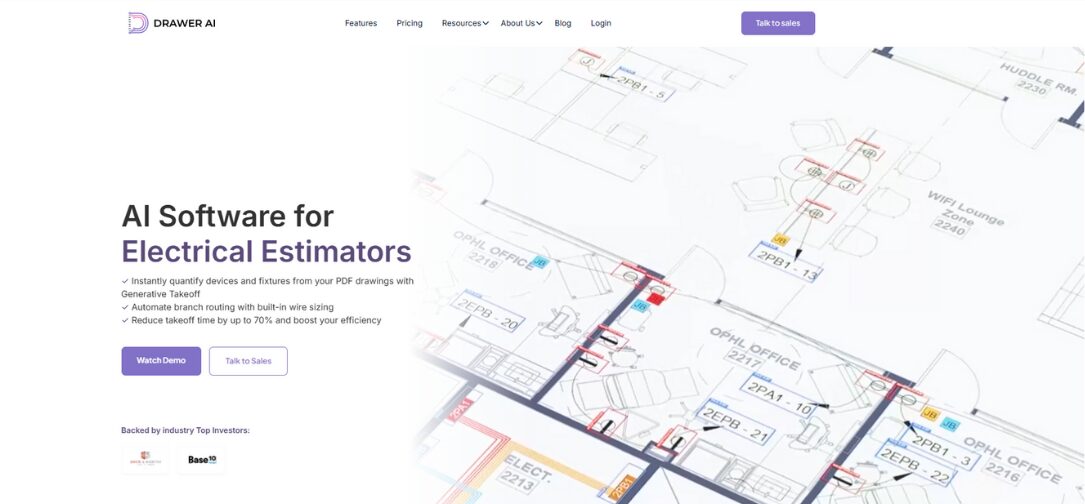Ever wondered how construction projects avoid going over budget? A big part of the answer lies in something called electrical estimating – the skill of predicting how much wiring, fixtures, labor, and materials will cost for any building project. Using the right solutions, like electrical cost estimating software, makes this task far less overwhelming than it sounds. With Drawer AI, you can revolutionize electrical estimating by simplifying and streamlining the process.
This guide will show you how estimating works from the ground up – literally.
What Is Electrical Estimating?
Electrical estimating is the process of figuring out how much it will cost to complete the electrical part of a building or renovation. This includes:
- Materials like wires, outlets, and breakers
- Labor costs for electricians
- Tools and rental equipment
- Overhead like travel, fuel, and storage
By creating an estimate, project managers can make sure they don’t overspend or undercharge clients. Think of it like drawing a treasure map – every line on that map needs a price tag!
Electrical estimating is essential for both large-scale commercial projects and residential renovations. Without it, projects could face unexpected costs, delays, and even legal issues.
Why Does Accurate Estimating Matter?
“Failing to plan is planning to fail.” – This couldn’t be truer in electrical work.
Without an accurate estimate, builders risk:
- Running out of supplies
- Paying workers longer than expected
- Delays in project timelines
- Angry clients or lost contracts
With electrical estimating software, users can streamline this entire process. The software uses artificial intelligence to scan blueprints, calculate take-offs (more on that below), and suggest pricing in real time. This means fewer mistakes and less stress for the team.
Accurate estimates also help keep clients happy. When clients see a well-prepared estimate, they feel confident in your ability to manage their project. This helps build trust and can lead to more business in the future.
Step-by-Step: The Electrical Estimating Process
Let’s break it down into clear stages. Each part plays a role in building a reliable cost forecast.
Project Documentation Review
Start by reviewing all documents: architectural drawings, electrical blueprints, and notes. This tells you:
- What the project looks like
- What materials are required
- The electrical load requirements
The better your understanding of the project, the more accurate your estimate will be. Without this key step, you might miss critical details, leading to budget overruns or delays.
Quantity Take-Offs
A take-off is the process of listing how many items you’ll need, like:
- 300 feet of wire
- 25 light fixtures
- 4 breaker panels
This becomes the “shopping list” for your estimate. It’s a crucial step because it sets the foundation for the rest of the estimate. If you miss a single item or miscount the quantity, your entire estimate will be off.
Labor Estimating
Now, figure out how long it will take to install each part and multiply that by local hourly rates. Labor is often the largest part of the cost, so estimating it accurately is critical to prevent overrun.
Different tasks require different amounts of time. For example, installing light fixtures takes less time than installing a complex electrical panel.
Labor Estimate Graph
Source: Bing Images
Tasks like installing outlets take less time than setting up a generator. That’s why electrical software solutions are handy – they calculate this for you based on best practices and your location. Many electrical cost estimating software programs have built-in labor rate databases based on geography, helping you remain competitive and accurate in your pricing.
Factor in Overhead and Profit
No project runs on materials alone. You also need to include:
- Office expenses
- Equipment wear-and-tear
- Insurance
- Mark-up for profit (typically 10–30%)
Think of it as a pizza – you’re not just charging for cheese and dough, but the chef’s time, electricity, rent, and delivery too! These costs aren’t visible to clients but are essential to your business’s sustainability.
Accurate overhead calculation ensures that you can pay bills, invest in new tools, and grow your business. The profit margin is your reward for doing a great job, covering all costs, and still remaining competitive.
Using Technology to Simplify Estimating
Gone are the days of clipboards and guesswork. With electrical cost estimating software, you can:
- Import digital blueprints
- Auto-generate materials lists
- Set labor rates
- Apply taxes and regional costs
- Export proposals in seconds
These tools save time and ensure accuracy. But the true power of these platforms lies in their ability to continuously update information based on real-time data, keep you ahead of the changes, ensuring that your estimates are up-to-date and competitive.
And the best part? You reduce errors, save time, and impress clients with neat, professional-looking bids.
FAQ – Common Estimating Questions
What if prices change mid-project?
Always update estimates regularly or add a “cost buffer” to account for market shifts. It’s essential to remain flexible and communicate any changes to your clients.
Can I estimate without a software tool?
Yes, but it’s slower and riskier. Using software ensures you don’t miss hidden costs. It’s like having a personal assistant who never forgets to update prices.
How do I know my labor time is accurate?
Study past projects, ask experienced electricians, or use electrical cost estimating software to apply standard labor hours. The software can give you a benchmark to guide you.
Wrapping It Up
Electrical estimating might sound technical, but it’s really about smart planning. Once you know how to break things into parts – materials, labor, overhead – you’ll be well on your way to mastering this skill.



































